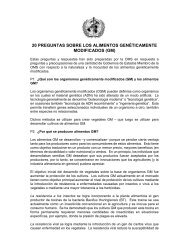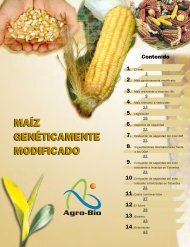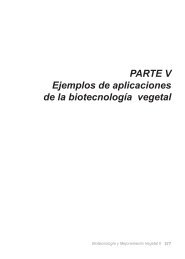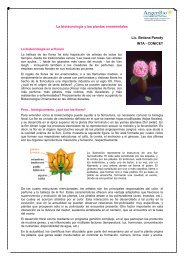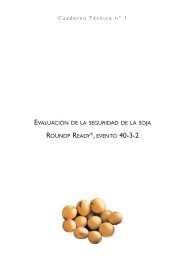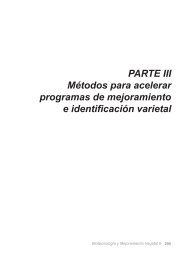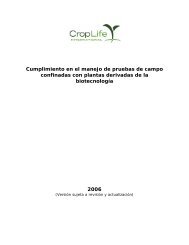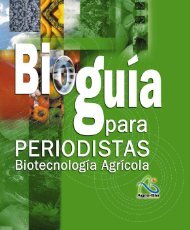8N E W G E N E T I C S, F O O D A N D A G R I C U LT U R Eaffluent place more emphasis on the quality of food, in termsof appearance, variety <strong>and</strong> nutritional content.Projections by the UN <strong>Food</strong> <strong>and</strong> <strong>Agriculture</strong> Organization( FAO) <strong>and</strong> the Inte r n ational <strong>Food</strong> Pol i cy Res e arch Insti tute(IFPRI) on the future dem<strong>and</strong> <strong>and</strong> supply of food necessary tokeep pa ce with po p u l ation grow th <strong>and</strong> changing dietaryhabits until 2020, predict increasing global dem<strong>and</strong> for food.For exam ple, ce real produ c tion for food <strong>and</strong> feed needs toincrease by 40 per cent, while livestock production needs todouble, to meet increasing dem<strong>and</strong> for milk <strong>and</strong> meat by year2020. At the same time, l<strong>and</strong> available for exp<strong>and</strong>ing agricultureis decre asing <strong>and</strong> water is an incre asingly scarceres o urce. Thus, more food needs to be produ ced per un i tavailable l<strong>and</strong>, per unit water.<strong>New</strong> developments in genetics must be assessed as to theirpo te n tial to co n tr i b ute to the produ c tion of more, cheape r,an d /or be tter quality food, in diffe rent situ ati o n s, <strong>and</strong> as totheir capacity to produce foods in ways that are more environ m e n tally sus tai n a ble when co m pared with present agr i-cultural practices <strong>and</strong> other technology options.2. ARE GM FOODS SAFE TO EAT?Cur re n tly avai l a ble geneti cally mod i fied foods are safe toe at. <strong>Food</strong> safe ty as s essments by national re g u l ato ry agenciesin seve ral co un tr i es have deemed cur re n tly avai l a ble GM food sto be as safe to eat as their co nve n tional co un te r parts <strong>and</strong> sui t-a ble for hum an co n s um p tion. This view is sh ared by seve ra li n te rg ove r n m e n tal agencies, including the FAO/WHO Cod e xAl i m e n tar i us Commission on food safe ty, which has 162 memberco un tr i es, the Euro pe an Commission (EC), <strong>and</strong> the Org an i-zation for Economic Coo pe ration <strong>and</strong> Development (OECD).Further, there is no evidence of any ill effects from the consum p tion of foods co n taining geneti cally mod i fied ingre d i-ents. Si n ce GM crops we re fi rst cu l tivated co m m e rcially in1995, many millions of meals have been made with GMi n gredients <strong>and</strong> co n s umed by pe o ple in seve ral co un tr i es,with no demonstrated adverse effects.Al though cur re n tly avai l a ble GM foods are co n s i d e re ds afe to eat, this does not guaran tee th at no risks will bee n co un te red as more foods are deve l o ped with novel charac te r i s ti cs. Ongoing eva l u ation of emerging products isrequired to ensure that new foods coming to market are safefor co n s um e rs. <strong>Food</strong> safe ty eva l u ation must be un d e r ta ke non a cas e - by - case basis. The extent of the risk eva l u ati o nshould be pro po r ti o n ate to the po s s i ble risks invol ved withparticular foods.There are also benefits to human health coming from GMfoods. These may be either direct be n e fits arising from th econtent of certain foods or indirect benefits, which arise fromchanging agricultural practices.Direct BenefitsImproved nutritional quality of specific foods (e.g. modifyings tarch co n tent in bar l ey, oil co n tent in ra pes e e d, or vitam i ncontent in rice).Re m oving allergens an d /or toxic co m po unds from ce r tai nfoods (e.g. peanuts).Indirect BenefitsPest tolerant crops can be grown with lower levels of chemicalpesticides, resulting in reduced chemical residues in food,<strong>and</strong> less exposure to pesticides.D i s e ase res i s tant crops may have lower levels of po te n ti a l l ycarcinogenic mycotoxins.3. WILL THERE BE ANY EFFECTS ONTHE ENVIRONMENT?A gr i cu l ture affects the env i ro n m e n t, th us it is to beexpected that new genetic technologies used in agriculturewill also affect the environment. The effect of genetic technologiesmay be either positive or negative—they may eitheraccelerate the environmentally damaging effects of agriculture,or they may contribute to more sustainable agriculturalp ra c ti ces <strong>and</strong> the co n s e rvation of natural res o urces. It is amatter of application <strong>and</strong> choice.To a large extent, the environmental effects will depend onthe specific genetic application, the agricultural system <strong>and</strong>
N E W G E N E T I C S, F O O D A N D A G R I C U LT U R E 9the env i ronment (agro - e co sys tem) in which it is used. Env i-ro n m e n tal impact should be as s essed on a cas e - by - cas ebas i s, taking acco unt of spe c i fic risk fa c to rs. The env i ro n-mental effects of specific technologies may be direct effectsof a spe c i fic trai t /s pe c i es co m b i n ation on biod ive rs i ty,h a b i tat s, lan d s ca pe, an d /or other co m ponents of the env i ro n-ment. Or, th ey may be indirect effe c t s, res u l ting from chan g-ing agr i cu l tural pra c ti ces leading to more, les s, or diffe rent us eof pes ti c i d es or herbicides, an d /or changing l<strong>and</strong> us es.In assessing direct <strong>and</strong> indirect environmental effects, newgenetic technologies should be compared with present agriculturalpractices, <strong>and</strong> with other technology options. Comparisonwith baseline ecol og i cal data is also des i ra ble, butdifficult to obtain in ma ny instances. Also, both the risks <strong>and</strong>the benefits of new technologies need to be considered, so asto develop a more complete picture of the options available<strong>and</strong> the implications of various choices.Direct environmental effectsFor example, in assessing the potential for direct environmentaleffects of plants, several factors should be taken intoaccount: the potential for gene flow from the crop plant tocompatible wild relatives in their centres of diversity, leadingto the formation of hybrids that survive <strong>and</strong> may cause environ m e n tal damage; the po te n tial of the pl ant to be come aweed in cu l tivated fields or to move outside the field tobe come an invas ive spe c i es in other habitats; the po s s i bl eeffects of specific traits on non-target organisms; <strong>and</strong> unexpectedeffects resulting from unintended genetic recombinations.These risks are similar to those carried by any pl an tre l e ased into the env i ronment. Geneti cally mod i fied pl an t sth at car ry par ti cu l ar traits (e .g . pest res i s tan ce) should beassessed for the effects that the particular trait may have onthese risk factors.In terms of direct effe c t s, gene fl ow is an issue—par ti cu l ar l yin regions wh e re crops are being cu l tivated in the vicinity ofl ocal l<strong>and</strong> ra ces, wild or we e dy re l atives with which th ey canc ross in nature, in their ce n tres of biol og i cal dive rs i ty. The ecolog i cal issue is not so much th at it happens (as pollen doesm ove in the wind <strong>and</strong> on insects, <strong>and</strong> some out - c rossing occursn aturally in ope n - pol l i n ated spe c i es), but does it matte r? Thean swer to the latter ques tion depends on wh e ther a novel trai tis introdu ced into a wild spe c i es th at incre as es the fi tn ess of th eres u l ting hybrids be tween the crop <strong>and</strong> its re l atives to surv ive<strong>and</strong> be come env i ro n m e n tally damaging (e .g . to be come aweed or an invas ive spe c i es). Ex pe r i m e n ta l l y, modelling bas e don biol og i cal <strong>and</strong> geogra phic data may be us e ful to predict th el i kely be h av i o ur of diffe rent spe c i es in var i o us env i ro n m e n t s,e i ther near to or distant from their ce n tres of dive rs i ty.Cur re n tly avai l a ble ev i d e n ce suggests th at genes canmove from GM crops into l<strong>and</strong> races <strong>and</strong> related wild species,g e n e rally at low fre q u e n cy <strong>and</strong> in are as wh e re co m pati bl ewild relatives are found. However, there is no evidence of anydeleterious environmental effects having occurred from thetrait/species combinations currently available.Indirect environmental effects due to changingagricultural practicesMost geneti cally mod i fied crops cur re n tly used co m m e r-cially have been mod i fied for either insect res i s tan ce an d /o rherbicide tol e ran ce. Insect-res i s tant crops should be us e dw i thin an inte grated pest management (IPM) sys tem to avo i dthe boo m/b ust cyc l es as s oc i ated with the build up of res i s tan cein the pest po p u l ation. There are some co n cerns as to wh e th e rI PM sys tems can be used effe c tively with GM crops in the deve l-oping wo r l d, <strong>and</strong> this is an area re q uiring fur ther action.Seve ral stu d i es have sh own th at the use of pes ti c i d es oncotton has declined globally by about 14 per cent since theintroduction of Bt cotton in the mid-1990s. Country studiesin Australia, China, South Africa <strong>and</strong> the USA show pesticidere du c tions of 40 to 60 per cent on GM co tton crops. Thereduction in p esticide use is accompanied by an increase inthe num ber of be n e ficial insects amongst the cro p - as s oc i-ated biod ive rs i ty. Herbicide tol e rant soy be an has be e nshown to increase the efficiency of weed control <strong>and</strong> reducesoil tillage, with consequent benefits for soil conservation.In the future, other environmental effects may result fromthe emerging scienti fic developments des i gned to mod i fyc rops with co m plex trai t s, which are co n trolled by multi pl egenes (e.g. tolerance to salinity or drought). This may enablea gr i cu l ture to extend into cur re n tly marginal l<strong>and</strong>s an d /o rthreaten fragile environments. For example, it may be possibleto cultivate saline-tolerant rice in areas currently impor-
- Page 1 and 2: I N T E R N ATIONAL COUNCIL FOR SCI
- Page 3 and 4: I N T E R N ATIONAL COUNCIL FOR SCI
- Page 7 and 8: N E W G E N E T I C S, F O O D A N
- Page 12 and 13: 10N E W G E N E T I C S, F O O D A
- Page 14 and 15: 12N E W G E N E T I C S, F O O D A
- Page 16 and 17: 14N E W G E N E T I C S, F O O D A
- Page 18 and 19: 16N E W G E N E T I C S, F O O D A
- Page 20 and 21: 18N E W G E N E T I C S, F O O D A
- Page 22 and 23: 20N E W G E N E T I C S, F O O D A
- Page 24 and 25: 22N E W G E N E T I C S, F O O D A
- Page 26 and 27: 24N E W G E N E T I C S, F O O D A
- Page 28 and 29: 26N E W G E N E T I C S, F O O D A
- Page 30 and 31: 28N E W G E N E T I C S, F O O D A
- Page 32 and 33: 30N E W G E N E T I C S, F O O D A
- Page 34 and 35: 32N E W G E N E T I C S, F O O D A
- Page 36 and 37: 34N E W G E N E T I C S, F O O D A
- Page 38 and 39: 36N E W G E N E T I C S, F O O D A
- Page 40 and 41: 38N E W G E N E T I C S, F O O D A
- Page 42 and 43: 40N E W G E N E T I C S, F O O D A
- Page 44 and 45: 42N E W G E N E T I C S, F O O D A
- Page 46 and 47: 44N E W G E N E T I C S, F O O D A
- Page 48 and 49: A n n e x e sA. Bibliographic ListB
- Page 50 and 51: N E W G E N E T I C S, F O O D A N
- Page 52 and 53: N E W G E N E T I C S, F O O D A N
- Page 54 and 55: N E W G E N E T I C S, F O O D A N
- Page 56 and 57: N E W G E N E T I C S, F O O D A N
- Page 58: I N T E R N ATIONAL COUNCIL FOR SCI



